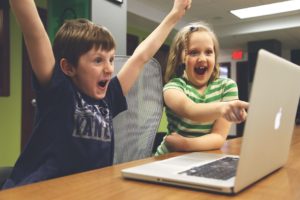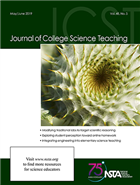Ed News: Project-Based Learning Boosts Student Engagement, Understanding
By Kate Falk
Posted on 2019-05-10

This week in education news, the last decade has seen widespread degree inflation; NCSE has developed a series of five climate change lessons for science teachers; new Florida bill requires schools to place a stronger emphasis on vocational and technical training and apprenticeships; Colorado lawmakers consider new education bills that are directed toward attracting and retailing teachers in the state’s more remote rural school districts; new report aims to help employers assess the impact of their STEM talent development efforts; and 39 percent of California high schools offer computer science courses.
Even More Teachers Can Now Have Their TEACH Grant Debt Forgiven
So far, about 2,300 teachers have had unfair federal loans forgiven, NPR has reported—and due to rule changes by the U.S. Department of Education, thousands more could get help. The Teacher Education Assistance for College and Higher Education, or TEACH grant, is meant to incentivize aspiring teachers to work in short-staffed areas and low-income schools. Teacher-candidates who plan to teach in a high-needs field, in a high-needs school, for at least four years are eligible for the $4,000 annual grant. Read the article featured in Education Week.
What If We Hired For Skills, Not Degrees?
The last decade has seen widespread ‘degree inflation.’ But a growing movement of employers, workers and training groups offers a rebuke to a culture that exalts a bachelor’s as the gold standard for upward mobility. Read the article featured in The Hechinger Report.
When Teaching Climate Change, Tackle The Myths Along With The Facts, Researchers Say
New research shows that an effective way to make adults more interested in climate change is to teach their children about it in school. More classes have been tackling the subject with help from the National Center for Science Education. Read the article featured in the Los Angeles Times.
Florida Passes Bill To Promote Career Training In Schools
Florida schools will help students plan for careers even if they don’t want to seek a four-year college degree under a wide-ranging education bill sent to Republican Gov. Ron DeSantis on Thursday. The bill will require schools to place a stronger emphasis on vocational and technical training and apprenticeships, beginning with required courses for middle school students on career and education training. Read the article by the Associated Press.
Stipends, Mentorship Programs Among Colorado Proposals To Address Rural Teacher Shortage
As Colorado lawmakers consider several new education bills this year, at least two are directed toward attracting and retailing teachers in the state’s more remote rural school districts. These measures would add to several programs created last year through legislation, which was designed to attract new teachers. Read the brief featured in Education DIVE.
Report Proposes Common Definition For Successful STEM Talent Development
A new report by professional services firm STEMconnector defines a successful result for talent development in the STEM fields as the emergence of “a diverse and STEM-ready talent pool with the knowledge, skills, and mindsets needed to secure and succeed in careers today and in the future.” Read the brief featured in Education DIVE.
Project-Based Learning Boosts Student Engagement, Understanding
A group of about 40 sixth graders at Stony Brook School has been trying to figure out when and where the next earthquake will hit outside of North America. The students researched continental plates and convection currents; they practiced graphing earthquake magnitudes; they looked at case studies in China, Japan and Nepal and considered how people adapt to an earthquake-prone environment; and, ultimately, they had to make their case, in writing, for why they expect the next earthquake to hit when and where they say it will, backing up their hypothesis with a well-reasoned argument and evidence. Read the article featured in The Hechinger Report.
California Moves To Get More K-12 Students Into Computer Science Classes
More California K-12 students at all grade levels could have access to computer science classes if schools implement a plan unanimously approved by the State Board of Education. Read the article featured in EdSource.
Pre-To-3: New Certification Recognizes Strong Early-Childhood STEM Programs
Leaders at AdvancED, the certification’s developer, want relevancy for classrooms serving infants and toddlers, not just those entering schools. Read the article featured in Education DIVE.
Stay tuned for next week’s top education news stories.
The Communication, Legislative & Public Affairs (CLPA) team strives to keep NSTA members, teachers, science education leaders, and the general public informed about NSTA programs, products, and services and key science education issues and legislation. In the association’s role as the national voice for science education, its CLPA team actively promotes NSTA’s positions on science education issues and communicates key NSTA messages to essential audiences.
The mission of NSTA is to promote excellence and innovation in science teaching and learning for all.
Follow NSTA

Managing an Active Class
By Gabe Kraljevic
Posted on 2019-05-10
 How do you maintain classroom management and control during active science lessons? I am curious about how to keep students under control when encouraging movement and active involvement in teaching.
How do you maintain classroom management and control during active science lessons? I am curious about how to keep students under control when encouraging movement and active involvement in teaching.
— A., Texas
I have always liked an active class—provided the activity is focussed on learning! Observing what is happening is important—so pick a spot in the room where the entire class is visible and set yourself up there. A corner is often the best. When helping someone, turn yourself to have as many students (or particularly sneaky ones) in front of you.
I think a key management strategy is having the class listen to you. Developing procedures to quiet the class is a good place to start. Use your teacher voice and be direct: “I need everyone back in their seats.”
Don’t talk over a class. Give one simple command and wait until all students have complied. Insist that students put everything down and face you before talking. When needed, you may want to count to three out loud. Most students respond quickly to this—especially if you have been using it all year.
A last resort for a rambunctious class would be to look at the clock and write the time you asked them to settle down on the board. Remain quiet until the last student is seated and looking forward. Write down this time. Add the delay time to the end of the period (provided it didn’t interfere with the next class or bussing). You’ll likely only need to do this once.
Hope this helps!
 How do you maintain classroom management and control during active science lessons? I am curious about how to keep students under control when encouraging movement and active involvement in teaching.
How do you maintain classroom management and control during active science lessons? I am curious about how to keep students under control when encouraging movement and active involvement in teaching.
— A., Texas
Supporting Emergent Multilingual Learners in Science, Grades 7–12
Ideas and inspiration from NSTA journals
By Mary Bigelow
Posted on 2019-05-09
Sometimes it seems like there are artificial boundaries in education: elementary vs. secondary, K-12 vs. higher education, middle school vs. high school. Having been an educator at all of these levels, I’ve found that there are more similarities than differences. If you take a few minutes to browse the table of contents for the journals that are outside your own teaching assignments (or read the blogs) you might identify a few articles of interest to download and read. For example, if you need a refresher on content, the secondary journals may help you. You may have students who could benefit from more advanced activities or students who need more fundamental experiences. You can see what the NGSS “looks like” at different grade levels. And get ideas for investigations that could be adapted for your grade level.
The Journal of College Science Teaching is another excellent NSTA resource with food for thought. It’s interesting that some of the articles in this higher education publication are about topics and issues with which K-12 teachers can identify, such as assessments, homework, the use of technology, and investigations. Even though the students described in these articles are older and more experienced, there are a lot of commonalities with science education at all levels. Best of all, unlike some higher education publications, the articles in JCST are very readable, not written in heavy “journalese.”
For example, in this year’s issues there have been articles about
- Organizing a course around a “big picture“
- Improving skills in using microscopes
- Helping preservice teachers analyze lessons for NGSS three-dimensional thinking
- Integrating technical writing in the laboratory
- Virtual vs face-to-face labs
- Difference between engagement and understanding
- Impacts of PowerPoint on learning
- Using the 5E format to create lessons from science research projects
- Practicing skills to enhance higher-order thinking
- Working with underrepresented students in science
- Modifying a traditional lab to enhance scientific reasoning
As an NSTA member you can download articles from all four journals as PDFs directly to your device. Or you can take advantage of NSTA’s Learning Center to save relevant articles in your own online library or organize them into a resource collection to share with colleagues.
Sometimes it seems like there are artificial boundaries in education: elementary vs. secondary, K-12 vs. higher education, middle school vs. high school. Having been an educator at all of these levels, I’ve found that there are more similarities than differences. If you take a few minutes to browse the table of contents for the journals that are outside your own teaching assignments (or read the blogs) you might identify a few articles of interest to download and read.


